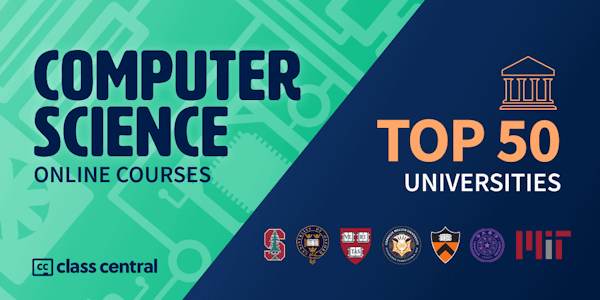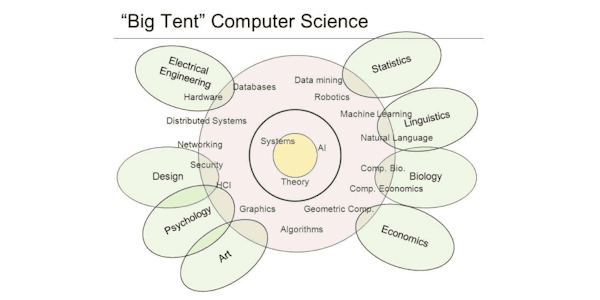The Hardware/Software Interface
University of Washington via Coursera
-
1.6k
-
- Write review
This course may be unavailable.
Overview
Class Central Tips
This course examines key computational abstraction levels below modern
high-level languages; number representation, assembly language, introduction
to C, memory management, the operating-system process model, high-level
machine architecture including the memory hierarchy, and how high-level
languages are implemented. We will develop students’ sense of “what really
happens” when software runs — and that this question can be answered at
several levels of abstraction, including the hardware architecture level,
the assembly level, the C programming level and the Java programming level.
The core around which the course is built is C, assembly, and low-level
data representation, but this is connected to higher levels (roughly how
basic Java could be implemented), lower levels (the general structure of
a processor and the memory hierarchy), and the role of the operating system
(but not how the operating system is implemented).
Syllabus
This course should develop students’ sense of “what really happens” when
software runs — and convey that this question can be answered at several
levels of abstraction, including the hardware architecture level, the assembly
level, the C programming level and the Java programming level. The core
around which the course is built is C, assembly, and low-level data representation,
but this is connected to higher levels (roughly how basic Java could be
implemented), lower levels (the general structure of a processor), and
the role of the operating system (but not how the operating system is implemented).
For (computer science) students wanting to specialize at higher levels
of abstraction, this could in the extreme be the only course they take
that considers the “C level” and below. However, most will take a subset
of Systems Programming, Hardware Design and Implementation, Operating Systems,
Compilers, etc. For students interested in hardware, embedded systems,
computer engineering, computer architecture, etc., this course is the introductory
course after which other courses will delve both deeper (into specific
topics) and lower (into hardware implementation, circuit design, etc.).
The course has three principal themes:
- Representation: how different data types (from simple integers to arrays of data structures) are represented in memory, how instructions are encoded, and how memory addresses (pointers) are generated and used to create complex structures.
- Translation: how high-level languages are translated into the basic instructions embodied in process hardware with a particular focus on C and Java.
- Control flow: how computers organize the order of their computations, keep track of where they are in large programs, and provide the illusion of multiple processes executing in parallel.
- understand the multi-step process by which a high-level program becomes a stream of instructions executed by a processor;
- know what a pointer is and how to use it in manipulating complex data structures;
- be facile enough with assembly programming (X86) to write simple pieces of code and understand how it maps to high-level languages (and vice-versa);
- understand the basic organization and parameters of memory hierarchy and its importance for system performance;
- be able to explain the role of an operating system;
- know how Java fundamentally differs from C;
- grasp what parallelism is and why it is important at the system level; and
- be more effective programmers (more efficient at finding bugs, improved intuition about system performance).
- Number representation
- Assembly language
- Basics of C
- Memory management
- Operating-system process model
- High-level machine architecture
- Memory hierarchy
- Implementation of high-level languages
Taught by
Luis Ceze
Tags
Reviews
4.6 rating, based on 12 Class Central reviews
Showing Class Central Sort
-
This course starts by taking off most of the nice things most programmers are accustomed to and tosses simple bit manipulation exercises on the face of students. While this may seem backward and antiquate, it forces students to think hard. This is e…
-
Coursera does not offer this course anymore. This was a tough course. Usually coursera courses have pass mark around 80% but this course demanded only 65% which is indicator of how difficult course it was. But if you have time, patience and interest to know how high level computer programs are broken down into low level machine readable codes you might want to try it. Memory management was also covered in the course.
-
It seems a very well crafted and interesting course, but not at all for beginners: you must have already had exposure to C language, and in general the pace of the course is fast
-
A few years ago I was trying to take this course. It wasn't easy and had plenty of quite challenging and very interesting hand-on assignment that gave understanding of the material. Regretfully the course was taken off by Coursera with no further explanation. I wish it was back.
-
I found this course on Youtube and it's really great. I learned a lot about how lower level computer stuff works. Highly recommend it to anyone interested in computer science!
-
-
-
-
-
-










